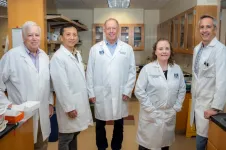(Press-News.org) PULLMAN, Wash. – A robotic bee that can fly fully in all directions has been developed by Washington State University researchers.
With four wings made out of carbon fiber and mylar as well as four light-weight actuators to control each wing, the Bee++ prototype is the first to fly stably in all directions. That includes the tricky twisting motion known as yaw, with the Bee++ fully achieving the six degrees of free movement that a typical flying insect displays.
Led by Néstor O. Pérez-Arancibia, Flaherty associate professor in WSU’s School of Mechanical and Materials Engineering, the researchers report on their work in the journal, IEEE Transactions on Robotics. Pérez-Arancibia will present the results at the IEEE International Conference on Robotics and Automation at the end of this month.
Researchers have been trying to develop artificial flying insects for more than 30 years, said Pérez-Arancibia. They could someday be used for many applications, including for artificial pollination, search and rescue efforts in tight spaces, biological research, or environmental monitoring, including in hostile environments.
But just getting the tiny robots to take off and land required development of controllers that act the way an insect brain does.
“It’s a mixture of robotic design and control,” he said. “Control is highly mathematical, and you design a sort of artificial brain. Some people call it the hidden technology, but without those simple brains, nothing would work.”
Researchers initially developed a two-winged robotic bee, but it was limited in its movement. In 2019, Pérez-Arancibia and two of his PhD students for the first time built a four-winged robot light enough to take off. To do two maneuvers known as pitching or rolling, the researchers make the front wings flap in a different way than the back wings for pitching and the right wings flap in a different way than the left wings for rolling, creating torque that rotates the robot about its two main horizontal axes.
But being able to control the complex yaw motion is tremendously important, he said. Without it, robots spin out of control, unable to focus on a point. Then they crash.
“If you can’t control yaw, you’re super limited,” he said. “If you’re a bee, here is the flower, but if you can’t control the yaw, you are spinning all the time as you try to get there.”
Having all degrees of movement is also critically important for evasive maneuvers or tracking objects.
“The system is highly unstable, and the problem is super hard,” he said. “For many years, people had theoretical ideas about how to control yaw, but nobody could achieve it due to actuation limitations.”
To allow their robot to twist in a controlled manner, the researchers took a cue from insects and moved the wings so that they flap in an angled plane. They also increased the amount of times per second their robot can flap its wings – from 100 to 160 times per second.
“Part of the solution was the physical design of the robot, and we also invented a new design for the controller – the brain that tells the robot what to do,” he said.
Weighing in at 95 mg with a 33-millimeter wingspan, the Bee++ is still bigger than real bees, which weigh around 10 milligrams. Unlike real insects, it can only fly autonomously for about five minutes at a time, so it is mostly tethered to a power source through a cable. The researchers are also working to develop other types of insect robots, including crawlers and water striders.
Pérez-Arancibia’s former PhD students at the University of Southern California, Ryan M. Bena, Xiufeng Yang, and Ariel A. Calderón, co-authored the article. The work was funded by the National Science Foundation and DARPA. The WSU Foundation and the Palouse Club through WSU’s Cougar Cage program has also provided support.
END
Researchers build bee robot that can twist
2023-05-23
ELSE PRESS RELEASES FROM THIS DATE:
How the COVID-19 pandemic impacted social cohesion
2023-05-23
Did the pandemic bring societies together or increase the drifting apart? That was one of the central questions posed by the scientists. "The empirical knowledge gained in this special issue deepens our understanding of the social consequences of the pandemic," says Dr. Mandi Larsen, a sociologist at Constructor University, "a well-founded scientific basis is also important in order to be able to better counteract future pandemics in socio-political terms." Together with her expert colleagues Dr. Georgi ...
Are we truly “inattentionally blind”? New study revisits “invisible gorilla” experiment for new insights
2023-05-23
We are quite good at spotting unexpected objects while focused on another activity if they are moving fast, reveals a new study by a team of New York University researchers. Their findings cast doubt on a long-standing view that our ability to see the unexpected is necessarily impaired when our attention is already directed elsewhere.
“For decades, it’s been thought that when we’re intently focused on something relevant, like driving or playing a game, we fail to spot something that unexpectedly enters our field of vision, even if it is clearly visible and moving,” says Pascal Wallisch, a clinical associate professor at New York University’s ...
Putting the brakes on accelerated aging of bone, muscle from HIV infection, treatment
2023-05-23
AUGUSTA, Ga. (May 23, 2023) – Antiretroviral cocktails can make human immunodeficiency virus, or HIV, undetectable and untransmittable, but both the virus and its treatment can also accelerate aging of bone and muscle.
Now Medical College of Georgia scientists are looking at drugs already being studied in clinical trials for cancer to help put the brakes on these classic indicators of aging that can lead to falls, fractures and early frailty.
“These drugs are doing what they are supposed to be doing: ...
Viewers actually 'binge-watch' TV with a lot of self-control
2023-05-23
If viewers sometimes feel guilty about binge-watching television programing, they really shouldn’t. Though its name implies impulsive behavior, binge-watching TV is a common activity planned out by viewers, suggests new research from the University of California San Diego’s Rady School of Management and School of Global Policy and Strategy.
The study, in collaboration with the Tepper School of Business at Carnegie Mellon University and Fox School of Business at Temple University, reveals that viewers prefer to binge-watch ...
Prescribed burns encourage foul-smelling invaders
2023-05-23
Though prescribed burns reduce wildfire threats and even improve habitat for some animals, new research shows these fires also spread stinknet, an aptly named weed currently invading superblooms across the Southwestern U.S.
Stinknet, also called globe chamomile, is native to South Africa, but is commonly seen in photos of California’s colorful superblooms. “Not all flowering plants are indicative of a healthy ecosystem,” said Loralee Larios, UC Riverside assistant botany professor and study co-author. “This one isn’t.”
In addition ...
Investigation reveals “shocking” epidemic of sexual assault in the NHS
2023-05-23
A joint investigation published today by The BMJ and The Guardian finds that NHS trusts recorded more than 35,000 cases of rape, sexual assault, harassment, stalking, and abusive remarks, between 2017 and 2022. The findings, which show that NHS trusts are failing to protect staff and patients, have led to calls for an independent inquiry.
The data, based on responses to Freedom of Information (FOI) requests from 212 NHS trusts and 37 police forces in England, show that a total of 35,606 sexual safety incidents were recorded ...
3 undergraduate researchers from Argonne selected for National Science Foundation Graduate Research Fellowship Program
2023-05-23
Argonne supports students’ ongoing engagement with the lab and scientific research by helping them secure a graduate fellowship.
Three students who have completed their participation in the Science Undergraduate Laboratory Internships (SULI) Science Undergraduate Laboratory Internships Program at the U.S. Department of Energy’s (DOE) Argonne National Laboratory were accepted into the National Science Foundation’s (NSF) Graduate Research Fellowship Program (GRFP). Their achievements highlight the important role Argonne plays in students’ continued engagement in science, technology, engineering and mathematics (science, technology, ...
UC San Diego first to test cancer drugs in space using private astronaut mission
2023-05-23
On May 21, 2023, scientists at University of California San Diego Sanford Stem Cell Institute launched several new nanobioreactor experiments onto the International Space Station (ISS) via the second Axiom Space Private Astronaut Mission, Axiom Mission 2 (Ax-2). The latest experiments expand their research on human stem cell aging, inflammation and cancer in low Earth orbit.
Increasing evidence shows that microgravity conditions can accelerate aging, inflammation and immune dysfunction in human stem cells. Understanding this process is not only helpful for keeping astronauts healthy — it could also teach us how to better treat ...
Research favors testing and voluntary isolation over closures in disease outbreaks
2023-05-23
Regular diagnostic testing and self-isolation can be more effective than school and business closures when it comes to combating infectious disease outbreaks such as COVID-19, according to a new study by University of Wyoming researchers.
The findings appear today (Monday) in Scientific Reports, an online, open access journal from the publishers of Nature.
UW Department of Economics faculty members Stephen Newbold, David Finnoff, Jason Shogren and Linda Thunstrom, along with recent Ph.D. graduate Madison Ashworth, developed an epidemiological and economic model to compare the effectiveness of physical distancing mandates with policies encouraging regular testing and ...
Researchers examine cooling power plants with brackish groundwater
2023-05-23
A new analysis led by a University of Wyoming researcher shows that brackish or salty groundwater has the potential to replace fresh water to cool coal- and natural gas-fired power plants and strengthen resilience in the energy infrastructure, although there’s a cost associated with doing so.
With freshwater supplies threatened due to drought, climate change and rapid socioeconomic growth, water competition is increasing between the electric power sector and other sectors. While transitioning to a low-carbon energy future, decarbonization of fossil fuel-fired power plants by carbon capture and storage would significantly ...







